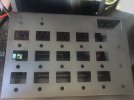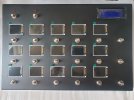Hey there
the sysex AMP/CAB name quest is interesting, but somewhat frustrating.
Seems with the AxeIII some of the sysex code is hidden and only given to 3rd party vendor(s) or they payd for it.
Anyway, here is my experience on this quest:
In the wiki is a functionality to extract the CAB name: (for the axe-fx 2)
GET_CAB_NAME
Message format:
HEADER BYTES 0x12 Function ID (0x12), 0xdd Cab Number, 0xdd Checksum, 0xF7 SysEx End
Response format:
HEADER BYTES 0x12 Function ID (0x12), 0xdd null-terminated string byte0, 0xdd byte1, ..., 0x00 null character, 0xdd Checksum, 0xF7 SysEx End
What interesting with this message, is that the 0x12 is bypassed in the third party devices midi document.
So i have had a great time chasing the dream of extracting the Cab name, but unfortunately i did not succeed
The sysex message i send whas:
0xF0, 0x00, 0x01, 0x74, 0x10 (standard header)
0x12 (function ID)
0x3E (Cab1 ID = 62 (62 decimal = 3E HEX)
0xB1 ( Sum of: f0 ^ 00 ^ 01 ^ 74 ^ 10 ^12 = B9) Sum of ( B9 ^ F7 = B1)
Send message: 0xF0, 0x00, 0x01, 0x74, 0x10, 0x12, 0x3E, 0xB1, 0xF7
Receive message: F0 00 01 74 10 64 12 01 62 F7 F0 00 01 74 10 64 12 00 63 F7 (20 characters)
This is the result i get each time when playing around with function ID hex etc. 0x15, 0x16,0x17... with the correct checksum for each new message, but no luck on any positive message from the AxeFxIII
BlockID information:
AMP1 = 58, AMP2 = 59, AMP3 = 60, AMP4 = 61. CAB1 = 62, CAB2 = 63, CAB3 = 64, CAB5 = 65
I have also done a lot of testing with several Send commands that are allready existing like from V8.2 of
@Piing : (they all work)
* Preset name:
Send message = 0xF0, 0x00, 0x01, 0x74, 0x10, 0x0D, 0x7F, 0x7F, 0x18, 0xF7 (0x18 = Checksum)
Receive message = F0 00 01 74 10 0D 01
00 50 65 74 72 75 63 63 69 20 52 69 67 20 32 30 32 30 20 20 20 20 20 20 20 20 20 20 20 20 20 20 00 6A F7. The actual ASCII conversion is: ð�t�Petrucci Rig 2020 �j÷
The letter P in HEX = 50, so the name is extracted after the 0x00 . The name is always 32 characters, so the 20 20 20 20 are spaces to fill the name up to 32 characters. What the function of the 00 is i have no clue. The ASCII for 00 = NULLNULL
Because i have not succeeded in my attempt to extract the CAB name i gave up and have made a request in the WISH thread:
https://forum.fractalaudio.com/threads/amp-cab-name-sysex-request-axefxiii.173024/
Hope to get a positive response on that request
If anyone has an idea on how to test it a little more .... i would be very interested.
Cheers





